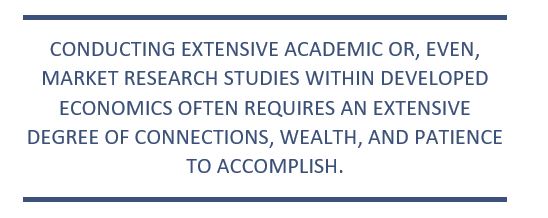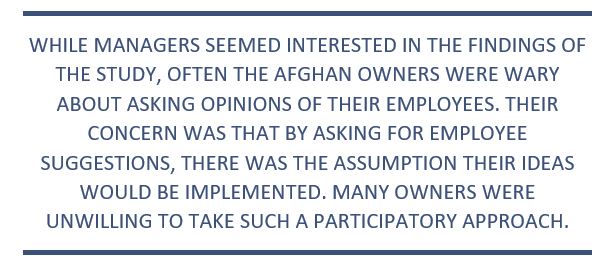A Brief Overview of Performance Improvement in the Developing World
While high-level change management models and workforce improvement implementation strategies have been tested to varying degrees within the modernized labor market, little applicability is present in the majority of underdeveloped economic systems.

The emerging markets are a fascinating realm of study for growth and opportunity. I remember the early 2000s being inundated with constant media chatter about Brazil, Russia, India, China, and South Africa (BRICS) solidifying as an increasingly competitive partner or rival to the current European and American globally dominant economic systems. Over time, the fascination with these countries and their monetary potential housed within emerging markets led to the promulgation of offshoring resources, a vast introduction of exchange traded funds focusing on these untapped markets, and even academic knowledge theorizing ground-up economic scale testing similar to the theories Milton Friedman tried to implement in South American investment and financial governance policies decades before1. However, recent years have proven to be unfriendly to the emerging markets. While all global economies vary in stagnation and growth, emerging markets have not kept pace with many developed countries and their initially christened massive market growth remains largely in question2. Scholars, historians, and economists alike have tried to narrow down the consequences of why this happened. Proposed ideas, such as anti-capitalism rhetoric or environmental regulations, have gained traction as possible sources of roadblock. In addition, others have noted that not enough time or leniency has transpired to allow these emerging markets to ignite properly. Poor governance methodology (despotism) and a lack of natural resources are also factors. In the end, however, I have always thought one major theme or idea continues to haunt this emerging world’s productivity to mirror that of an advanced economy, one that the developed economies have already somewhat mastered, – the art of workforce development.
We have little research available to us, unfortunately. Conducting extensive academic or, even, market research studies within developed economics often requires an extensive degree of connections, wealth, and patience to accomplish. Unstable local governmental systems, public sector corruption, civil refugee activity, inflation, and employment migration are all major setbacks that can limit a bipartisan researcher’s ability to truly gauge an accurate understanding of local employment and workforce customs. In addition, there are considerable cultural differences that must be accounted for. Similar to Maslow’s famous Hierarchy of Needs, every individual has a different perception of their immediate needs (food, comfort, safety, etc.) of preference, based on environmental and geopolitical stability within their community. From a business standpoint, income (or the ability to progressively move up the power/responsibility ladder) and happiness are primarily the talking points whenever a study is conducted in a developed economy. In some ways, it is artificially comical that the word happiness would even be measured against career, work, employment, or service, etc. for many in the developing markets
In order for us to more accurately disseminate how workforce improvement would even be executed in foreign areas of the world, we have to empathetically approach the subjects, as if we were in their situation. The circumstances they inhabit are one of intense instability, non-structured compensation and rewards systems, poor working conditions, and often aggressive supervisory oversight that most advanced economics are no longer accustomed to. I’ve taken some time to locate several research studies that have attempted to implement a proper change management model into a developing economic source. I’ve located a rather substantial case study coming out of Afghanistan that details survey results and other findings for a regional, urban bank chain. The team of researchers that executed the survey are experienced workforce development professors and industry professionals. While the less than lucrative nature of studying the developing world most likely dissuades large private sector investment, the rather limitless potential of enacting and discovering new workforce development techniques, based off culture or geographical area, is significant. The hope is that business academics and industry research-oriented teams are more inclined to pivot to the developing world’s influence as the emerging economies and other underdeveloped regions reach a more pivotal future role in the global landscape and economic manpower.
A company’s employee base is only as good as the policies it sets forth to cultivate and enrich that group. Some companies are hardline with their rules which limits employee growth. Some are stagnant or stubborn in their innovation which limits attracting new talent. Lastly, some are profit-driven and radical which supplements low workforce morale. In all situations, one common solution is often rooted in the change management policies set forth. Change is a difficult venture to execute within an already established corporate culture or employee workforce.  However, when successful and conducted correctly, the analysis or implementation of change can have prominent effects on workforce productivity, morale, company growth, and employee retention. To achieve this successful mode of change, we must utilize tools and modeling to better understand, analyze, and theorize how best to initiate the change and capture its better qualities towards a finer solution of improvement. In Stull and Freer’s Perceptions of Performance Improvement Factors in an Emerging Market Environment, we are afforded the opportunity to view the results of a complex performance analysis test/survey in an emerging market environment. Published in 2019, the research we are about to explore attempts to convey a story from which we can extract data points and a conceptual understanding, based on the model implemented, that will give us an idea towards better identifying alongside the problems or successes that assist or damage workforce development in an emerging market environment.
However, when successful and conducted correctly, the analysis or implementation of change can have prominent effects on workforce productivity, morale, company growth, and employee retention. To achieve this successful mode of change, we must utilize tools and modeling to better understand, analyze, and theorize how best to initiate the change and capture its better qualities towards a finer solution of improvement. In Stull and Freer’s Perceptions of Performance Improvement Factors in an Emerging Market Environment, we are afforded the opportunity to view the results of a complex performance analysis test/survey in an emerging market environment. Published in 2019, the research we are about to explore attempts to convey a story from which we can extract data points and a conceptual understanding, based on the model implemented, that will give us an idea towards better identifying alongside the problems or successes that assist or damage workforce development in an emerging market environment.
EXAMPLE CASE STUDY
Afghanistan Regional Retail Bank
Reference: Stull, Stephen H. & Freer, Kevin F. (2019). Perception of Performance Improvement Factors in an Emerging Market Environment. Performance Improvement Quarterly, 31(4), 327-354. DOI:1002/piq.21269
Stull and Freer use Thomas Gilbert’s Behavior Engineering Model (BEM). Created in 1978, BEM ranks six factors – Data (information), Instruments (resources), Incentives, Knowledge, Capacity, and Motives. The factors were ranked by importance starting with Data and ending with Motives. “The BEM, as a cause analysis model supporting the performance improvement (PI) process, was developed in the context of U.S. business organizations. PI practitioners have questioned whether the BEM would be applicable in a different cultural environment” (327). Gilbert devised BEM from his findings while working in the private sector. He led himself to believe that training was not a primary factor in improving workplace performance. Instead, Gilbert conceived that management had a much more profound effect on workplace performance which derived mostly from their ability to cultivate a supportive workplace environment. The International Society for Performance Improvement (ISPI) publishes the PI (Performance Improvement) / HPT (Human Performance Technology) model which incorporates and takes influence from parts of BEM. This model’s legacy in performance analysis has been well-established for the past four decades.
A banking establishment in Afghanistan was selected as the primary conduit of implementing BEM’s mode of analysis. Stull and Freer were interested in the fact that BEM, while considered sound in its practicality and utilization in the U.S. workplace, could not cross into another culture with the same ranking of factors. From the emerging market realm, Afghanistan stood out as a source of test because the researchers were in the country on a separate international development consulting engagement. Stull and Freer make it clear that culture seems to be of significant relation to the success of performance improvement. In other words, BEM may not be able to have a traditional effect on this Afghanistan bank but will provide insight on the hierarchical needs of the six factors laid out in BEM. The order of significance would, assumedly, change because of the differing cultural beliefs found in Afghanistan versus the already tested U.S.  environment. Stull and Freer deployed: “A quantitative instrument [BEM] measured the awareness of the factors in the sample population. Qualitative research with group discussion followed to explore in depth the responses to the quantitative questionnaire” (333). In addition to understanding our model and tools of analysis, the research indicates wide involvement among the staff. “The participants in the study were managers and nonmanagerial administrative, service, and technical staff in the head office of a major commercial bank in Afghanistan with approximately 2,300 employees across its nationwide branch network. Participants for the study were drawn from some 600 employees in the head office in Kabul, focusing on the professional staff directly involved in the banking services and operations” (335). However, while the tools and stakeholders were in place, projected roadblocks were envisioned and mitigated for. “Due to a reassignment out of Kabul, a research assistant was needed to collect data for this research. There was concern with the validity of the research instrument as a mechanism for representing the perceptions of the target population in an environment not accustomed to survey questionnaires and one in which the instrument had not been used” (339). Lastly, while findings were established, the research proved to be difficult to collect and stubborn in its integrity. “Preparing instruments and forms in the two official local languages as well as in English added complexity to the research process. Limitations in travel due to security concerns further complicated the data collection effort. Even within the capital city, travel restrictions limited follow-up meetings with the participating organization. Finding businesses in Kabul that were willing to have their employees participate in the study was a major obstacle. While managers seemed interested in the findings of the study, often the Afghan owners were wary about asking opinions of their employees. Their concern was that by asking for employee suggestions, there was the assumption their ideas would be implemented. Many owners were unwilling to take such a participatory approach” (339).
environment. Stull and Freer deployed: “A quantitative instrument [BEM] measured the awareness of the factors in the sample population. Qualitative research with group discussion followed to explore in depth the responses to the quantitative questionnaire” (333). In addition to understanding our model and tools of analysis, the research indicates wide involvement among the staff. “The participants in the study were managers and nonmanagerial administrative, service, and technical staff in the head office of a major commercial bank in Afghanistan with approximately 2,300 employees across its nationwide branch network. Participants for the study were drawn from some 600 employees in the head office in Kabul, focusing on the professional staff directly involved in the banking services and operations” (335). However, while the tools and stakeholders were in place, projected roadblocks were envisioned and mitigated for. “Due to a reassignment out of Kabul, a research assistant was needed to collect data for this research. There was concern with the validity of the research instrument as a mechanism for representing the perceptions of the target population in an environment not accustomed to survey questionnaires and one in which the instrument had not been used” (339). Lastly, while findings were established, the research proved to be difficult to collect and stubborn in its integrity. “Preparing instruments and forms in the two official local languages as well as in English added complexity to the research process. Limitations in travel due to security concerns further complicated the data collection effort. Even within the capital city, travel restrictions limited follow-up meetings with the participating organization. Finding businesses in Kabul that were willing to have their employees participate in the study was a major obstacle. While managers seemed interested in the findings of the study, often the Afghan owners were wary about asking opinions of their employees. Their concern was that by asking for employee suggestions, there was the assumption their ideas would be implemented. Many owners were unwilling to take such a participatory approach” (339).
Stull and Freer’s findings were complementary to the initial concerns that BEM’s six factors (and other Performance Improvement models) would not translate cross-culturally in level of importance, based on Gilbert’s U.S. ranking. Workplace improvement factors are ranked differently in Afghanistan and, in our bank’s case, the participants believed that Incentives were the most critical and important factor. Economic conditions, in particular, played a major role where incentives, such as the continuity of pay (i.e. job security) and salary, were viewed as very desirable towards improving workplace performance. In this study’s case, the employer performed very poorly in meeting this Incentive category benchmark. However, the employer ranked well in Capacity (Capability) which was the second most highly ranked factor behind Incentive for the employees. Stull and Freer concluded, “While the results of the study indicated the relative importance of the environmental supports provided by management compared to individual factors, the results emphasized the perceived importance of Incentives for improving performance. The concern for job security and assurance of income may well be more a function of economic rather than of cultural considerations” (345).
Change management professionals should strongly take into consideration what was exhibited in these Afghanistan findings. This study provided unique workplace perspective into a well-educated workforce at a banking institution in a developing country – one that would be difficult to label an emerging economy, as well. However, what we learn from Stull and Freer here is that numbers are not the sole attribute towards measuring areas, such as performance improvement. Qualitative factors have a considerable bastion of influence on both workplace morale and expectations. There are values and principles that are difficult to adequately measure but pivotal in understanding. For example, our bank employees in this study had very real concerns about job security. This was partly attributed to the fact that the Afghanistan economy is still insurmountably affected by war, poverty, and corruption in addition to varying religious and sectarian influence. A consistent, reliable income is most likely a vastly more important subject for these individuals than the hours they worked, elaborate décor in the office, supervisor reassurance, or workforce collaboration and training. A proper change agent would recognize these cultural values from the start and consider them in parallel to the raw numbers or findings that they are prepared to weaponize on behalf of executing new performance improvement strategies.
 The considerably fascinating element about Stull and Freer and others’ findings is that performance improvement studies are often never isolated in their influence. External factors, such as public policy directions or unemployment, have a certain level of impeded progress over a workforce group’s tolerance level for certain, more economically agreeable values or needs. In some cases, it may not even be the company’s fault that employees have low morale or major performance concerns. With globalization becoming an increasingly powerful force in our world, it is believed that mass integration and assimilation could occur. However, we see from the Afghanistan case, that individual country culture still plays an incredible role. People’s beliefs and values often transcend corporate normalized doctrine and, while a multi-national company may not have to deal with ground-level performance perception issues at the home office, the satellite branches do. As Stull and Freer also make note of, though, it is in our best interest as a globally connected economic system to practice and implement strategically placed analysis on performance and change improvement methodologies across cultures so we may better understand the emerging and untapped economies of tomorrow.
The considerably fascinating element about Stull and Freer and others’ findings is that performance improvement studies are often never isolated in their influence. External factors, such as public policy directions or unemployment, have a certain level of impeded progress over a workforce group’s tolerance level for certain, more economically agreeable values or needs. In some cases, it may not even be the company’s fault that employees have low morale or major performance concerns. With globalization becoming an increasingly powerful force in our world, it is believed that mass integration and assimilation could occur. However, we see from the Afghanistan case, that individual country culture still plays an incredible role. People’s beliefs and values often transcend corporate normalized doctrine and, while a multi-national company may not have to deal with ground-level performance perception issues at the home office, the satellite branches do. As Stull and Freer also make note of, though, it is in our best interest as a globally connected economic system to practice and implement strategically placed analysis on performance and change improvement methodologies across cultures so we may better understand the emerging and untapped economies of tomorrow.
1 https://miltonfriedman.hoover.org/friedman_images/Collections/2016c21/SundayTimes_1976_4.pdf
2 https://www.msci.com/documents/10199/3653ff70-93d4-4e88-9c4e-70d8efb10923



